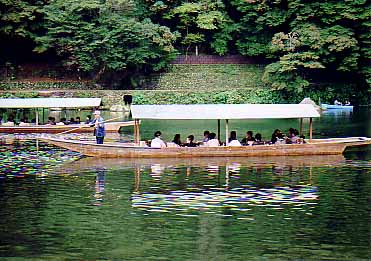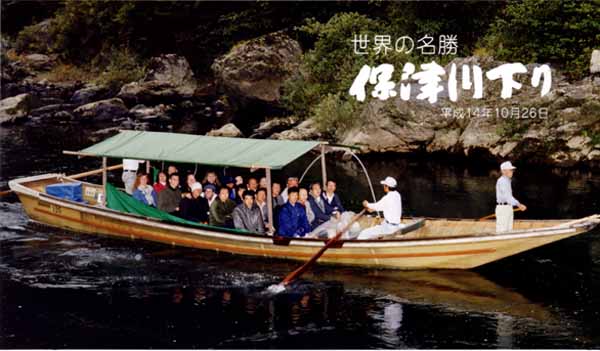
| Main Page |
| Photo Galleries |
| Writing |
| Aikido |
| Zen |
| Peeps |
| Links |
| Contact |

 Hozu
River
Hozu
River
 The
hills of Western Kyoto are famed for their scenic beauty, particularly
in the autumn season, and there is no better way to take it all in than
by boat down the Hozu River.
The
hills of Western Kyoto are famed for their scenic beauty, particularly
in the autumn season, and there is no better way to take it all in than
by boat down the Hozu River.
A boat line runs from Kameoka in the North to Arashiyama further South. The trip meanders down the winding length of the river through all of the mountains and gorges of Western Kyoto.
 Accessible
easily by train, the Arashiyama-Sagano area is a treasure trove of beautiful,
rolling mountains and breathtaking temples and garden. Stepping off the
train at Kameoka station, one is greeted immediately by the welcome sight
of open rice fields and wide meadow filled with flowers (above).
Accessible
easily by train, the Arashiyama-Sagano area is a treasure trove of beautiful,
rolling mountains and breathtaking temples and garden. Stepping off the
train at Kameoka station, one is greeted immediately by the welcome sight
of open rice fields and wide meadow filled with flowers (above).
Incongruously, however, there is a large apartment buidling and carpark on the opposite side of the tracks...but I'll refrain from a detailed description of that part. More about meadows and fields.
 A
short walk from the station is the Hozu river, where you can catch a ride
on boats leaving hourly. The roughly two hour-long trip downstream winds
through some gorgeous scenery, with plenty of wildlife along the way to
keep things interesting.
A
short walk from the station is the Hozu river, where you can catch a ride
on boats leaving hourly. The roughly two hour-long trip downstream winds
through some gorgeous scenery, with plenty of wildlife along the way to
keep things interesting.
Though I have managed to keep from mentioning it so far, I feel I must
indulge myself at least a little and talk about monkeys. As you may or
may not know, I love monkeys.  Furry
little people who always eat stuff and cause trouble, can you ever stay
mad at a monkey? Well, Arashiyama is also known as Monkey Mountain, a
detail that had by no means escaped my attention.
Furry
little people who always eat stuff and cause trouble, can you ever stay
mad at a monkey? Well, Arashiyama is also known as Monkey Mountain, a
detail that had by no means escaped my attention.
As the boat made yet another of the wide, sweeping turns around a bend in the river, we were greeted with the sight of a troupe of monkeys (minkees) hanging out on the riverbanks. Some might say that this was a bad time for me to run out of film, but I was mollified by the fact that I had at least seen some monkeys...and who can get mad about that?
But I digress. No more talk of monkeys. I believe there was a boat ride that day, as well...
 The
boats themselves are long, traditional style craft manned by three or
more people, depending on the season and the strength of the river. Ours
was manned by three; one to row with an oar lashed to the boat, one to
skull and another to push with a bamboo pole.
The
boats themselves are long, traditional style craft manned by three or
more people, depending on the season and the strength of the river. Ours
was manned by three; one to row with an oar lashed to the boat, one to
skull and another to push with a bamboo pole.
One of the boatmen was a very old man, and we were quite surprised to see him skilfully pad his way up the gunnels of the boat to take the bow, pushing and prodding the boat down the river with the bamboo pole. He somehow made it all look very natural, and you could tell it was done with an ease that could only be achieved with the benefit of many years of practice.
|
|
In one rather conspicuous display of proficiency, the old boatman was able to land the tip of his pole in a small hole approximately an inch and a half in diameter in a rock, pushing us clear as we sped out of the rapids. The tiny hole had been slowly worn into the rock over the ages by the many generations of travellers plying the waters of the Hozu river.
The trip down the river took us past cranes and herons along the banks,
as well as cormorants, ducks and monkeys (of course!).  The
soft sand along the rivers edge also showed the signs of the deer and
wild boar that come to the waters of the Hozu Gawa to drink.
The
soft sand along the rivers edge also showed the signs of the deer and
wild boar that come to the waters of the Hozu Gawa to drink.
Before the boat cruises into the calm waters of Arashiyama, it is waylaid by a number of skiffs selling food and refreshments. The boatmen are given a much deserved rest as the boats are lashed together and their toil is replaced, if only temporarily, by the power of a Yamaha. We warmed ourselves with a hot cup of amazake, a sweet, unfermented rice wine.
 The
journey ended in Arashiyama, a small mountainous area replete with charming
restaurants and beautiful temples. It is also home to Monkey Park...but
that's another story...
The
journey ended in Arashiyama, a small mountainous area replete with charming
restaurants and beautiful temples. It is also home to Monkey Park...but
that's another story...

